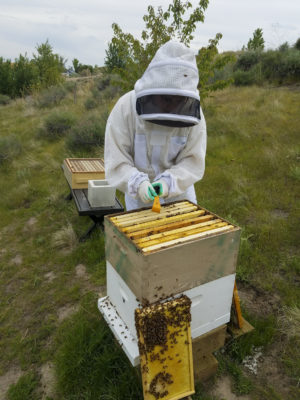New strain of fungus helps regrow honey bee population
WSU researchers develop thermotolerant strain of mite-killing fungus

“This is a big deal for the beekeeping industry … a lot of the varroa treatments that we have right now, aren’t as effective,” said Jennifer Han, postdoctoral research associate.
June 11, 2021
WSU researchers from the College of Agricultural, Human, and Natural Resource Sciences published a paper covering their newly developed strain of Metarhizium fungus, which kills mites that harm honey bees.
Postdoctoral research associate Jennifer Han and assistant research professor Nicholas Naeger are both members of the Department of Entomology and took the lead on this project.
The project aims to help increase the honey bee population by targeting one of the insect’s main threats: varroa mites, Han said.
“[Varroa is] a parasite,” she said. “It uses mouthparts to rip a hole in the bee’s exoskeleton, and it feeds on the fatty tissue inside the bee.”
The danger varroa mites pose to honey bees led to the development of many chemical-based pesticides that are successful in killing the mites. However, research shows the pesticides are harmful to bees, and the mites are growing resistant to the chemicals, Han said
The main chemical-free method of killing the varroa mites without harming honey bees is Metarhizium fungus, Han said.
“Our big project for this paper was basically breeding a better fungus that can live in the hives and kill mites better,” she said.
Metarhizium fungus typically only lives in cooler environments, so the biggest hurdle the team had to face was breeding a fungus tolerant to the higher temperature of a beehive, Han said.
“The beehives thermoregulate to be about 35 degrees Celsius, which is about 90 degrees Fahrenheit,” she said. “This fungus was not very thermotolerant; [it] couldn’t handle the heat.”
Han said through years of directed evolution in the lab and field, the team was able to develop their own strain of thermotolerant Metarhizium fungus designated as strain JH1078.
The team worked for over two years on developing the fungus, which included counting every varroa mite and checking them for fungus after being tested, Naeger said.
“We counted … at least 27,000 [varroa mites on] petri dishes, so we can look for fungal growth,” he said. “Basically [we would do] a little mite autopsy to find out what killed them.”
Han and Naeger are trying to find companies that are interested in licensing the fungus with help from the WSU Office of Commercialization, so they can manufacture and sell it to commercialized honey bee farms, Naeger said.
“This is a big deal for the beekeeping industry,” Han said. “Because … a lot of the varroa treatments that we have right now, aren’t as effective.”
The fungus strain has been successful thus far, so now the team is testing the best ways to use it in beehives, Naeger said.










Ronald Rhodes • Jun 11, 2021 at 10:42 pm
You people make me proud to be a WSU graduate. Good work.